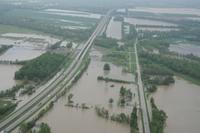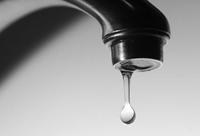-
Recipe for radioactive materials helps in studies of nuclear waste and fuel storage pools
Easy-to-follow recipes for radioactive compounds like those found in nuclear fuel storage pools, liquid waste containment areas, and other contaminated aqueous environments have been developed by researchers at Sandia National Laboratories; the trick to the recipes is choosing the right templates; these are atoms or molecules that direct the growth of compounds in much the way islands act as templates for coral reefs
-
-
Portable technology provides drinking water, power to villages, military
Researchers have developed an aluminum alloy that could be used in a new type of mobile technology to convert non-potable water into drinking water while also extracting hydrogen to generate electricity; such a technology might be used to provide power and drinking water to villages and also for military operations
-
-
Missouri levee blast floods 130,000 acres, but saves Illinois city

On Tuesday, the U.S. Army Corps of Engineers blasted a section of a levee along the Mississippi River to create a controlled breach that would relieve pressure and prevent the town of Cairo, Illinois from becoming engulfed in record flood levels; the blast created a gap more than 10,000 feet wide at Birds Point, Missouri levees and inundated more than 130,000 acres of farmland; heavy rains have left the Mississippi and Ohio Rivers swollen, putting Cairo and its 3,000 residents at great risk as it sits on a narrow stretch of land between the two surging rivers; on Monday, the Corps received permission from the federal government to go ahead with its plan, despite Missouri’s protests
-
-
What past rises of sea levels tell us about future rises
During a period of high atmospheric carbon dioxide levels three million years ago — the mid-Pliocene climate optimum — sea levels were anywhere between 15 and 100 feet higher than at present because water that is now locked up in glaciers as ice circulated freely through the oceans; by understanding the extent of sea level rise three million years ago, scientists hope more accurately to predict just how high the seas will rise in the coming decades and centuries due to global warming
-
-
Sector Report for Monday, 2 May 2011: Infrastructure protection
This report contains the following stories.
Plus 1 additional story.
-
-
California roads to generate renewable energy
California lawmakers recently passed a bill for a pilot program that would turn road vibrations into energy; the bill proposes using a process called piezoelectric generation that captures energy from cars, trains, or people as they move across surfaces and create vibrations; these vibrations are then harnessed and converted into energy by piezoelectric materials that would be buried beneath the road’s surface; a .6 single lane road can prove as much as forty-four megawatts of energy each year, which is enough to light up more than 30,000 homes
-
-
Solving nuclear fuel storage problem more crucial than ever: MIT report
The Japan nuclear crisis adds to the urgency of dealing with radioactive used fuel, and may raise cost of new plants, MIT Energy Initiative study says; the report recommends that an interim solution be developed to remove spent fuel storage facilities at reactor sites, and move to regional, medium-term repositories where the fuel can be monitored and protected as it decays over time
-
-
Study finds natural gas releases twice as much greenhouse gas as coal
A new study shows that natural gas is not as environmentally friendly as previously thought, dealing a major blow to environmentalists who viewed it as a “bridge fuel” to cleaner energy alternatives; researchers found that the greenhouse-gas footprint of shale gas over a twenty year period was at least 20 percent higher than coal and could even be “more than twice as great”; the study was quick to draw criticism from oil and gas companies for its use of shoddy data; the study also outlines multiple ways that the oil and gas companies could reduce methane emissions by up to 90 percent during the drilling process
-
-
West Texas towns face impending water shortage
West Texas is facing a dire drought that has local officials scrambling to find additional sources of water for thirsty residents; since last October, West Texas has only seen about one-tenth of an inch of rain, and now two of the three reservoirs that cities in the Permian Basin depend upon are nearly empty; the third reservoir is 30 percent below capacity; without significant rain soon, all three reservoirs will be dry by January 2013; residents have been restricted to only three days of outdoor watering; the region faces limited options for additional sources of water and plans will be expensive to implement
-
-
California school building regulators had ties with anti-regulation lobby group
A California watchdog group recently revealed that state officials in charge of enforcing earthquake standards for school buildings have had a long and questionable relationship with a lobbying group that actively works to oppose building safety regulations in public schools; senior officials with the Division of the State Architect had been dues paying members of the Coalition for Adequate School Housing, which actively lobbies for less regulation on school construction; in 1997, state regulators were told that taxpayers would reimburse their membership dues to be a part of the lobbying group; officials maintain that there has been no corruption; in 2010 a major regulatory provision in place since 1933 was removed
-
-
Fears over nuclear energy stall Kentucky nuclear plans
Days before the 11 March earthquake and tsunami struck Japan causing its ongoing nuclear crisis, a bill that would have eased restrictions on the construction of a nuclear power plant in Kentucky failed to pass the state legislature dashing the hopes of atomic energy advocates; the proposed site currently houses a uranium enrichment facility, but it is expected to be shut down in the near future leaving 1,200 people out of work; safety advocates are concerned because the site is located near the New Madrid seismic zone; Kentucky generates 90 percent of its power from coal, and Governor Beshear proposed in 2008 to use nuclear power to generate 30 percent of the state’s energy by 2030
-
-
Intrusion detection company joins chemical society
The growing attention to chemical plants safety leads perimeter security companies to show even more interest in that sector; Senstar, a manufacturer of perimeter intrusion detection technology, joins the Society of Chemical Manufacturers and Affiliates
-
-
New guide explains perimeter protection options
A new guide explains the subject of perimeter protection clearly and concisely to enable specifiers, facilities managers, security managers, and consultants to identify the optimum security measures for particular premises and threats; it covers not only high-security fencing, barriers, and gates, but also electric pulse systems and associated security measures such as access controls, CCTV, and intrusion detection systems
-
-
U.K. struggles to reduce water usage as supplies dwindle

An uncharacteristically warm and dry spring in the United Kingdom has forced water companies to begin conserving water, but a recent survey indicates that the method currently employed is widely unpopular and grossly affects low income families; some reservoirs are 20 percent below normal levels and eleven rivers are at their lowest in twenty years; in 1989 the British government mandated that all new homes have water meters installed and introduced a usage plan which charges households based on the amount of water they consume; the plan has proven effective in reducing water usage, but costs have increased by more than 50 percent
-
-
Iran's control systems attacked by another virus

Iran admitted it has been attacked by another virus aiming to disrupt its industrial control systems; the commander of Iran civil defense said, though, that the virus has been caught in time and neutralized by Iran’s “young experts”; Gholamreza Jalali described the virus as “congruous and harmonious with the (computer) system and in the initial phase it does minor damage and might be mistaken for some executive files of government organizations”; in the summer, nearly 42,000 computers and servers in Iran’s industrial control systems — many of them in Iran’s nuclear weapons program — were infected; the damage to uranium enrichment centrifuges was especially great, causing Iran in mid-November to halt enrichment operations; Stuxnet has also infected the Bushehr nuclear reactor; the reactor was supposed to come on line in August, but it is still not operational, and has missed several start-up deadlines
-
More headlines
The long view
Helping Strengthen America’s Critical Infrastructure
By Corinne Dionisio
Everyday life depends on a robust infrastructure network that provides access to running water, communications technology and electricity, among other basic necessities. The experts who keep our national infrastructure secure and resilient also need a strong network to share their knowledge and train the next generation of professionals capable of solving complex infrastructure challenges.
AI and the Future of the U.S. Electric Grid
By Doug Irving
Despite its age, the U.S. electric grid remains one of the great workhorses of modern life. Whether it can maintain that performance over the next few years may determine how well the U.S. competes in an AI-driven world.
Using Liquid Air for Grid-Scale Energy Storage
By Nancy W. Stauffer
New research finds liquid air energy storage could be the lowest-cost option for ensuring a continuous power supply on a future grid dominated by carbon-free but intermittent sources of electricity.
Enhanced Geothermal Systems: A Promising Source of Round-the-Clock Energy
By Julie Bobyock and Christina Procopiou
With its capacity to provide 24/7 power, many are warming up to the prospect of geothermal energy. Scientists are currently working to advance human-made reservoirs in Earth’s deep subsurface to stimulate the activity that exists within natural geothermal systems.
Experts Discuss Geothermal Potential
By Graeme Beardsmore and Rachel Webster, University of Melbourne
Geothermal energy harnesses the heat from within Earth—the term comes from the Greek words geo (earth) and therme (heat). It is an energy source that has the potential to power all our energy needs for billions of years.
